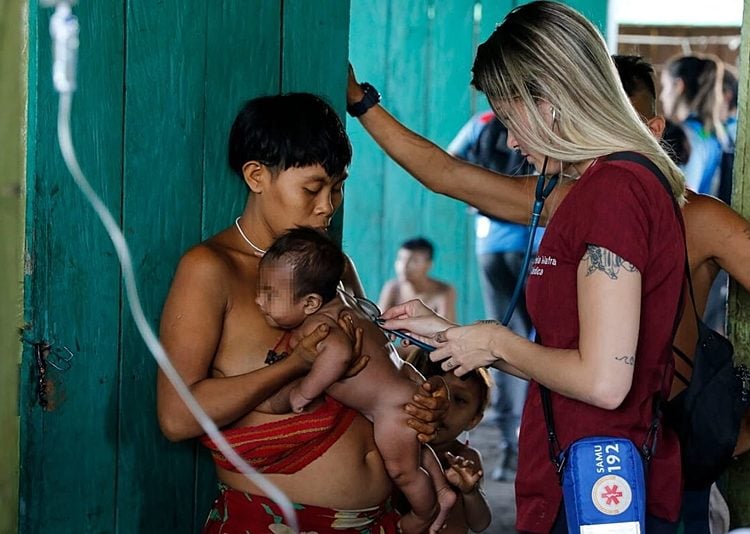A study by the Oswaldo Cruz Foundation (also known as Fiocruz) that the Jair Bolsonaro (Liberal Party) government tried to sabotage was made public on Thursday (4). It revealed a clear association between illegal mining and mercury contamination in the Yanomami Indigenous Land. The situation mainly affects pregnant women and children.
"We are facing a tragedy. There is no other word to define it. And this tragedy has multiple impacts that extend to different areas of the lives of native peoples," Paulo Basta, a doctor and researcher at Fiocruz, told Brasil de Fato.
Among the consequences are alarming rates of anemia, malaria and chronic malnutrition, especially among pregnant women and children. Mercury, which is used to separate gold from other substances, was found in 100% of the almost 300 Yanomamis examined, with the highest levels of contamination in Indigenous communities near gold mines.
"In severe cases of chronic mercury exposure, women are often unable to carry a pregnancy to term and suffer repeated miscarriages. When they manage to give birth, but have high levels of mercury in their bodies, the children can be born with congenital deformities, different genetic syndromes, cerebral palsy, among other health conditions," says the researcher.
The study also found that:
- Only 15.5% of children have up-to-date vaccinations
- Acute malnutrition affects more than half of children under the age of 11
- Anemia cases were recorded in 25% of children under 11
- More than 80% of the people examined had malaria at least once, with an average of three infections per person.
- 80% of children had a height deficit, indicating chronic malnutrition
Yanomami children's IQ below average
Paulo Basta explained that mercury passes through the mother's placenta to the baby. Yanomami children who were born apparently healthy ended up presenting impaired intellectual development.
"When a pregnant woman eats fish contaminated with mercury, it is absorbed in the gastrointestinal tract, falls into the bloodstream, is distributed throughout the body and, via the placenta, reaches the developing fetus," Paulo Basta explained.
Tests adapted to Indigenous peoples' cultures indicated that the average intelligence quotient (IQ) of children was 68, below the general average expected in tests of this kind, which is 100. According to the study, many of these Yanomami children had intelligence considered borderline, average or below. In one of the Indigenous communities, only one child scored within the average IQ range.
"A child who has delays in neurodevelopmental milestones will, for instance, take a long time to sit up, to support their head, to crawl, to take their first steps and to speak. They won't play in the same way as other children, will have learning difficulties and will get notes from their teacher saying they're not following the instructions at school," says the Fiocruz doctor.
The Bolsonaro government tried to ban research
The research led by Fiocruz was carried out in October 2022 with the Yanomami Indigenous people from the Ninam subgroup. Teams made up of doctors, biologists and geographers visited nine Indigenous communities on the Upper Mucajaí River, one of the areas most affected by illegal mining.
A year earlier, in October 2021, the researchers requested authorization to enter Yanomami Indigenous Land. However, they were barred by the National Foundation for Indigenous Peoples, also known as Funai. The agency's justification was the COVID-19 pandemic, although the team of nine doctors was there to work on health issues.
"It was a clear political maneuver to sabotage our work and make it impossible to evaluate the population at that time," said Paulo Basta.
The Fiocruz doctor says that Funai's refusal caused outrage and frustration among the team, which was already mobilized to enter the Yanomami Indigenous Land. According to him, it could be that the data would have been even more alarming had researchers carried out their work following the original schedule.
"With the end of the pandemic decree, in April 2022, we filed a new request, which Funai couldn't deny again," he recalled.
Diseases won't disappear by expelling invaders
All 287 Yanomamis tested had mercury in their bodies: 84% had levels of contamination above 2 micrograms, and almost 11% had more than 6 micrograms, which is considered a high level that requires special attention and further investigation.
The region where the study took place is currently serving as a stronghold for armed illegal miners who are defying the expulsion operation led by the federal government, which began in January 2023 but has so far failed to complete the removal of the invaders.
"If not a single drop of mercury is dumped on Yanomami land from today on, we will have to manage all these effects for at least a century. It can remain in the environment in different forms for up to 100 years," explains Basta.
Brasil de Fato contacted the Hutukara Yanomami Association, which represents the Yanomami people, to comment on the study's results, but problems with the Indigenous leaders' schedules prevented the interview from taking place.
The study is Impacto do mercúrio em áreas protegidas e povos da floresta na Amazônia: uma abordagem integrada saúde-ambiente [Impact of mercury on protected areas and forest peoples in the Amazon: an integrated health-environment approach, in rough translation]. The work was carried out by the Sergio Arouca National School of Public Health (Ensp/Fiocruz) in partnership with the Joaquim Venâncio Polytechnic School of Health (EPSJV/Fiocruz) and was supported by the Socio-Environmental Institute (ISA, in Portuguese).




